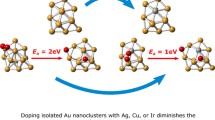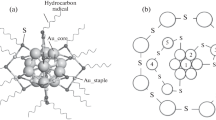Abstract
The reactivity of Cu, Ag, and Au nanoparticles and of the corresponding (111) surfaces of these elements toward CO oxidation and NO2 reduction has been investigated by means of DFT and DFT-D calculations. The co-adsorption energies of CO and O on Ag and Au surfaces are smaller than that corresponding to Cu surface but the oxidation reaction is energetically more favored for the heavier metals. The adsorption energy of NO2, Eads, is about 50 % larger on nanoparticles than on the metal perfect surfaces, following the almost general rule stating that the lower coordinated sites are those where the interaction is the largest. Interestingly for the co-adsorption and oxidation of CO an increase of reactivity is found for the Au nanoparticles, which is attributed to the large number of low coordinated sites due to the specific shape of this nanoparticle induced by the adsorbates.









Similar content being viewed by others
References
Haruta M (1997) Size- and support- dependency in the catalysis of gold. Cat Today 36:153–166
Valden M, Lai X, Goodman DW (1998) Onset of catalytic activity of gold clusters on Titania with the appearance of nonmetallic properties. Science 281:1647–1650
Wallace WT, Whetten RL (2002) Coadsorption of CO and O2on selected gold clusters: evidence for efficient room-temperature CO2 generation. J Am Chem Soc 124:7499–7505
Sanchez A, Abbet S, Heiz U, Schneider W-D, Hakkinen H, Barnett RN, Landman U (1999) When gold is not noble: nanoscale gold catalysts. J Phys Chem A 103:9573–9578
Iizuka Y, Tode T, Takao T, Yatsu K, Takeuchi T, Tsubota S, Haruta M (1999) A kinetic and adsorption study of CO oxidation over unsupported fine gold powder. J Catal 187:50–58
Herzing AA, Kiely CJ, Carley AF, Landon P, Hutchings GJ (2008) Nanoclusters on iron oxide supports for CO oxidation. Science 321:1331–1335
Rodriguez JA, Illas F (2012) Activation of noble metals on metal-carbide surfaces: novel catalysts for CO oxidation, desulfurization and hydrogenation reactions. PhysChemChemPhys 14:427–438
Rodriguez JA, Evans J, Feria L, Vidal AB, Liu P, Nakamura K, Illas F (2013) CO2 hydrogenation on Au/TiC, Cu/TiC and Ni/TiC catalysts: production of CO, methanol and methane. J Catal 307:162–169
Valden M, Pak S, Lai X, Goodman DW (1998) Structure sensitivity of CO oxidation over model Au/TiO2 catalysts. Cat Lett 56:7–10
Hvolbæk B, Janssens TVW, Clausen BS, Falsig H, Christensen CH, Nørskov JK (2007) Catalytic activity of Au nanoparticles. NanoToday 2(4):14–18
Roldán A, González S, Ricart JM, Illas F (2009) Critical Size for O2 dissociation by Au nanoparticles. ChemPhysChem 10:348–351
Roldán A, Ricart JM, Illas F (2009) Influence of the exchange-correlation potential on the description of the molecular mechanism of oxygen dissociation by Au nanoparticles. Theor Chem Acc 123:119
Turner M, Golovko VB, Vaughan OPH, Abdulkin P, Berenguer-Murcia A, Tikhov MS, Johnson BFG, Lambert RM (2008) Selective oxidation with dioxygen by gold nanoparticle catalysts derived from 55-atom clusters. Nature 454:981–983
Gajdoš M, Hafner J, Eichler A (2006) Ab initio density-functional study of NO on close-packed transition and noble metal surfaces: I. Molecular adsorption. J Phys Condens Matter 18:13–40
Gajdoš M, Hafner J, Eichler A (2006) Ab initio density-functional study of NO adsorption on close-packed transition and noble metal surfaces: II. Dissociative adsorption. J Phys Condens Matter 18:41–54
Torres D, González S, Neyman KM, Illas F (2006) Adsorption and oxidation of NO on Au(111) surface: density functional studies. Chem Phys Lett 422:412–416
Lemire C, Meyer R, Shaikhutdinov S, Freund H-J (2004) Do quantum size effects control CO adsorption on gold nanoparticles? Angew Chem Int Ed 43:118–121
Ovesson S, Lundqvist BI, Schneider WF, Bogicevic A (2005) NO oxidation properties of Pt(111) revealed by ab initio kinetic simulations. Phys Rev B 71:115406 (1–5)
Gates BC (1995) Supported metal-clusters - synthesis, structure, and catalysis. Chem Rev 95:511–522
Ertl G (2008) Handbook of heterogeneous catalysis. Wiley-VCH, Weinheim
Anderson JA, Fernández-García M (2011) Supported metals in catalysis, 2nd edn. Catalytic science series: Vol 11, Imperial College Press, London
Viñes F, Gomes JRB, Illas F (2014) Understanding the reactivity of metallic nanoparticles: beyond the extended surface model for catalysis. Chem Soc Rev. doi:10.1039/c3cs60421g
Brønsted N (1928) Acid and basic catalysis. Chem Rev 5:231–338
Evans MG, Polanyi NP (1938) Inertia and driving force of chemical reactions. Trans Faraday Soc 34:11–24
Boudart M (1997) In:Ertl G, Knözinger H, Weitkamp J (eds.) Handbook of heterogeneous catalysis. Wiley-VCH, Weinheim, p 1
Logadottir A, Rod TH, Nørskov JK, Hammer B, Dahl S, Jacobsen CJH (2001) The brønsted–evans–polanyi relation and the volcano plot for ammonia synthesis over transition metal catalysts. J Catal 197:229–231
Viñes F, Vojvodic A, Abild-Pedersen F, Illas F (2013) Brønsted-evans-polanyi relationship for transition metal carbide and transition metal oxide surfaces. J Phys Chem C 117:41681
Grabow LC, Studt F, Abild-Pedersen F, Petzold V, Kleis J, Bligaard T, Norskov JK (2011) Angew Chem Int Ed 50:4601
Fajin JLC, Cordeiro MNDS, Illas F, Gomes JRB (2010) Descriptors controlling the catalytic activity of metallic surfaces towards water splitting. J Catal 276:92
Fajín JCL, Cordeiro MNDS, Illas F, Gomes JRB (2014) Generalized brønsted-evans-polanyi relationships and descriptors for O-H Bond cleavage of organic molecules on transition metal surfaces. J Catal 313:24
Kresse G, Hafner J (1993) Ab initio molecular-dynamics for liquid-metals. Phys Rev B47:558
Kresse G, Hafner J (1993) Ab initio molecular-dynamics for open-shell transition-metals. Phys Rev B 48:13115
Kresse G, Hafner J (1994) Ab initio molecular-dynamics simulation of the liquid-metal amorphous-semiconductor transition in germanium. Phys Rev B 49:14251
Kresse G, Furthmüller J (1996) Efficient iterative schemes for ab initio total-energy calculations using a plane-wave basis set. Phys Rev B 54:11169
Kresse G, Furthmüller J (1999) Efficiency of ab-initio total energy calculations for metals and semiconductors using a plane-wave basis set. Comp Mat Sci 6:15
Blöchl PE (1994) Projector augmented-wave method. Phys Rev B50:17953
Perdew JP, Chevary JA, Vosko SH, Jackson KA, Pederson MR, Singh DJ, Fiolhais C (1992) Atoms, molecules, solids, and surfaces - applications of the generalized gradient approximation for exchange and correlation. Phys Rev B 46:6671–6687
Perdew JP, Chevary JA, Vosko SH, Jackson KA, Pederson MR, Singh DJ, Fiolhais C (1993) Atoms, molecules, solids, and surfaces: applications of the generalized gradient approximation for exchange and correlation (46:6671, 1992) Phys Rev B 48:4978
Perdew JP, Burke K, Ernzerhof M (1996) Generalized gradient approximation made simple. Phys Rev Lett 77:3865–3868
Janthon P, Kozlov SM, Viñes F, Limtrakul J, Illas F (2013) Establishing the accuracy of broadly used density functionals in describing bulk properties of transition metals. J Chem Theory Comput 9:1631–1640
Zhao Y, Truhlar DG (2006) A new local density functional for main-group thermochemistry, transition metal bonding, thermochemical kinetics, and noncovalent interactions. J Chem Phys 125:194101
Ashcroft NW, Mermin ND (1976) Solid state physics. Saunders College Publishing, Orlando, p 335
Janthon P, Luo SA, Kozlov SM, Viñes F, Limtrakul J, Truhlar DG, Illas F (2013) Bulk properties of transition metals: a challenge for the design of universal density functionals. J Chem Theory Comput. doi:10.1021/ct500532v
Grimme S (2006) Semiempirical GGA-type density functional constructed with a long-range dispersion correction. J Comp Chem 27:1787–1799
Roldán A, Viñes F, Illas F, Ricart JM, Neyman KM (2008) Density functional studies of coinage metal nanoparticles: Scalability of their properties to bulk. Theor Chem Acc 120:565
Monkhorst HJ, Pack JD (1976) Special points for brillouin-zone integrations. Phys Rev B 13:5188
Fajin JLC, Illas F, Gomes JRG (2009) Effect of the exchange-correlation potential and of surface relaxation on the description of the H2O dissociation on Cu(111). J Chem Phys 130:224702
Hollins P, Pritchard J (1979) Interactions of CO molecules adsorbed on Cu (111). Surf Sci 89:486–495
Vollmer S, Witte G, Wöll C (2001) Determination of site specific adsorption energies of CO on copper. Cat Lett 77:97–101
Mc Elhiney G, Papp H, Pritchard J (1976) The adsorption of Xe and CO on Ag(111). Surf Sci 54:617–634
Elliot GS, Miller DR (1984) Proc 14th Int Symp on rare field gas dynamics. University of Tokyo Press, Tokyo, pp 349–358
Beret EC, Ghiringhelli LM, Scheffler M (2011) Free gold clusters: beyond the static, monostructure description. Faraday Discuss 152:153–167
Beret EC, van Wijk MM, Ghiringhelli LM (2014) Reaction cycles and poisoning in catalysis by gold clusters: a thermodynamics approach. Int J Quantum Chem 114:57–65
Habas M-P, Mele F, Sodupe M, Illas F (1999) Density functional cluster model study of bonding and coordination modes of CO2 on Pd(111). Surf Sci 431:208–219
Rodriguez AH, Branda MM, Castellani NJ (2006) DFT studies of the adsorption and interaction of two methanol molecules on a MgO edge. THEOCHEM 769:249–254
Acknowledgments
This work was supported by the Spanish MICINN grant CTQ2012-30751 and, in part, by the Generalitat de Catalunya 2014SGR97 XRQTC project. F.I acknowledges additional funding through the 2009 ICREA Academia award.
Author information
Authors and Affiliations
Corresponding author
Additional information
This paper belongs to Topical Collection QUITEL 2013
Rights and permissions
About this article
Cite this article
Pascucci, B., Otero, G.S., Belelli, P.G. et al. Comparative density functional theory based study of the reactivity of Cu, Ag, and Au nanoparticles and of (111) surfaces toward CO oxidation and NO2 reduction. J Mol Model 20, 2448 (2014). https://doi.org/10.1007/s00894-014-2448-5
Received:
Accepted:
Published:
DOI: https://doi.org/10.1007/s00894-014-2448-5




